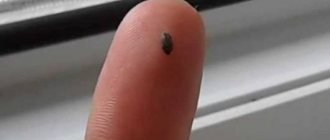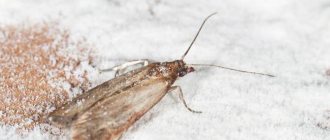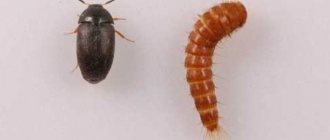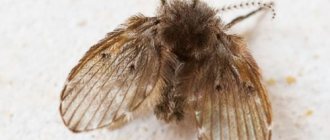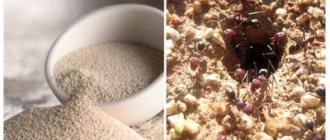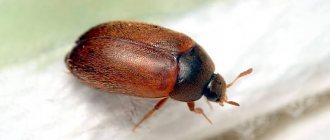The weevil is a pest that enters your apartment at lightning speed and literally spoils your food in a matter of minutes. These parasites can be found in every corner of our vast world. They can't fly, but that doesn't stop them from moving from point A to point B at the speed of light. How exactly, you will read in the article.
If you suddenly find a weevil in your apartment, then this is a signal that you need to immediately take measures to destroy it, since this pest lays a lot of eggs. By the way, you can only find and see adult individuals, since the eggs and larvae are in “seeds”, and it is completely unknown how many eggs are hidden there and what scale of tragedy awaits you after hatching. Therefore, this is a rather important issue that needs to be looked at “under a microscope.”
Appearance of weevil
In general, the history of the weevil began in distant Ancient Egypt. They can be found in any apartment, especially if you store your food incorrectly (we are talking about cereals).
Even then, the pest got into storage, barns where cereals were stored and destroyed everything in its path. In general, weevils prefer tropical climates, but if they find themselves in more severe conditions, they will be able to adapt and survive in such a climate.
Over the many years of existence, these pests have not lost their power and continue to harm humans, causing damage to food. That is why it is important to fight the weevil in the first stages of its appearance.
At the very beginning of its development, the weevil reaches a length of about 3.5 millimeters and has a light brown color. As it grows older, its color scheme changes to darker tones. The pest received such a strange name due to the non-standard structure of its head and elongated nose. He can't fly because he doesn't have wings.
He moves at lightning speed thanks to his paws, with which he pushes off.
A distinctive feature of the weevil and other pests is that with its powerful jaws it can gnaw through any packaging and then begin to spoil the food. The optimal temperature for its existence should be 11-26 degrees, with an air humidity of 65%.
The female beetle simply chews the grains, in which it lays its eggs. Hatching time takes about two weeks, after which the larvae hatch, eat the grains, gnaw through the wall of the cereal and climb out, after which they can be seen. Now you understand that it is impossible to detect and count how many eggs a female has laid.
The structure of weevils differs slightly from their species. They come in two types:
- Short-proboscis.
- Long-proboscis.
Their main feature is the length of the rostrum and the location of the mouthparts. They can also develop inside the plant or in the soil. Pests can reproduce only at warm temperatures. Some species can produce offspring without fertilization. If the climate is favorable for weevils, they can give birth all year round.
Where do weevils come from in apartments and why should they be removed?
The weevil gets into the home in cereals, which housewives bring from stores or market stalls. If no action is taken to eliminate insects in warehouses or barns, they will infest supplies. It is very difficult to notice a colony of bugs in packaged products. Since each grain in which an egg is laid is carefully sealed with specific mucus. Subsequently, it becomes hard, reliably covering the future bug. Thus, insects can be noticed much later than their appearance in purchased products.
It is worth getting rid of weevils in the kitchen not only because they transfer food, but because they are carriers of fungal infections and bacteria dangerous to people. Their secretions can cause various allergic reactions. Therefore, at the first signs of appearance, you need to fight them with all available means.
Important!
It is almost impossible to notice weevils. Their larvae resemble sticky grains of semolina. Therefore, they cannot be seen in flour, but they can be detected quite easily in buckwheat and nuts.
Types of weevil
It is fundamentally important to know not only how weevils get into apartments or how they harm products, but also the types of pests. In general, there are about 65 thousand species in the world. But in our country there are about 54 thousand of them. There are such types as:
- barn weevil - it cannot fly, but it moves very quickly using its legs. The length of the body is small, but this does not prevent him from eating a lot and often. Prefers to feast on flour, cereals and pasta;
- rice weevil - this type of weevil has wings and thanks to them it also moves quickly. It feeds not only on rice, as the name suggests. Can enjoy bread and other cereals. Also, this type of pest can spoil grains in the fields;
- striped weevil - feeds not only on cereals, but also on leaves and roots of shoots. Mainly attacks legumes. This species can completely ruin your entire garden;
- Fruit Weevil – These pests will cause damage to fruit plants and trees. They feed on everything from the trunk to the tops of branches with leaves;
- nut weevil . Here you can guess from the name what it eats. But it not only eats nuts, but also lays eggs in them. When spring begins, bugs hatch from nuts and begin to spoil everything that comes their way.
What danger do weevils pose to humans and their homes? Pests enter an apartment in different ways, mainly together with cereals, as they penetrate into storage facilities and settle down quite comfortably there. Depending on the type of beetle, they can spoil absolutely everything.
It is important to understand this point: the weevil is not a predator. He will not bite a person. But it causes harm through food. If you eat porridge made from cereals where the weevil lived, you can easily get an intestinal upset.
People with allergic diseases are generally contraindicated from eating contaminated cereals, as this can cause serious illness.
These pests can be carriers of infectious diseases, as well as fungal ones.
Description of the pest
It is quite difficult to see what a weevil looks like, because the size of an adult individual is on average 3.5 mm. At the initial stage of its development it is colored light brown, but as it grows it becomes very dark in color. And it got its name from a special elongated rostrum that crowns its body, which resembles a cylinder in shape. The weevil insect cannot fly, but it moves very quickly with the help of its legs.
A distinctive feature of this species is its very powerful jaws, so weevils in an apartment or warehouse can easily destroy the integrity of the packaging material and get to the food. For their comfortable existence, they need a temperature from 10°C to 25°C, humidity within 65%, as well as the humidity of the products themselves (grains) about 15%.
The female gnaws “burrows” in the grains and lays eggs there, from which larvae emerge two weeks later. As they develop, they eat the grain from the inside and pupate. The hatched bug gnaws through the wall and ends up outside. It is precisely because of this method of development that pests are very difficult to detect at an early stage. Adult individuals become noticeable.
There are a great many species of these pest beetles, and all of them are not only resistant to various changes in the environment, but also absolutely omnivorous. The main types of domestic weevils that may end up in our apartments include the following:
- The granary weevil lives in the grain. This small brown bug has a very good appetite and, multiplying quickly, is capable of infecting a warehouse with cereals and flour in a very short time;
- A relative of the granary weevil is the rice weevil. It is a little smaller in size, but causes massive damage. The main part of his diet consists of cereals, corn, peas, pasta, crackers;
- As the name implies, the nut pest with a proboscis causes the main damage to its stock of hazels and walnuts. Having made a hole in the shell, the female lays eggs, from which larvae emerge and destroy the kernels;
- The oak variety is also quite large.
Barn
Distributed everywhere, weevils in wooden houses most often belong to this species. This is a dark brown beetle, 3-4 mm long, with a long proboscis and underdeveloped wings, does not fly, but runs nimbly and can move quite long distances. The eggs of the insect are 0.6-0.7 mm long, yellowish in color.
Granary weevil larvae are up to 3 mm long, legless, with a brown head. Beetle larvae eat grains: rice, wheat, barley and rye. They eat away the entire middle, leaving only the shell.
Home
Females gnaw holes in the grains, lay an egg there, from which a larva emerges after 1-2 weeks. It feeds on the contents of the grain and then comes out, breaking through its shell.
Walnut
Damages hazel fruits and walnuts and enters the house with them. Females are 8-9 mm long, males are shorter - 6-7 mm. They have long curved proboscis – 6 mm and 4 mm respectively. The bugs are black, covered with thick yellowish-gray scales on top.
Rice
It is called rice because it was first discovered by Linnaeus in rice grains. But more often it develops in soft wheat and other grains. The rice weevil is similar to the granary weevil; its development proceeds in exactly the same way: eggs, larvae and pupae resemble the same stages in the granary weevil in size and shape. However, adult beetles are smaller - 2.5 - 3.5 mm in length. They are brown, with a matte or slightly shiny surface. Females can lay up to 5 hundred eggs, which is more than the barn egg.
The rice species spoils beans, corn, wheat, millet, rye and hemp grain, barley, rice, oilseeds, and is therefore considered more harmful.
Ways to combat weevils
If you notice that weevils are living in your cereal, you need to take action immediately. It is possible and necessary to fight them.
After you have discovered a pest in the cereal, you must carefully check all the food products that were stored next to the infected package and immediately throw all the cereals that you think have been eaten by the weevil into the trash.
Those food products that were not in the source of infection must be isolated away from the site of infection and secured. This can be done by sharply increasing or decreasing the temperature. You can place all the “saved” bags of food in the freezer for several days, or, conversely, put them in the oven for several hours. 120 degrees will be enough to destroy the pest.
After discovering the weevil, you need to wipe all the walls of the cabinets, all handles, shelves, doors, etc. with soapy water, then wipe dry and spray with vinegar or a vinegar solution.
This is the first stage of pest control. However, this is far from the end; then either chemical methods of struggle or folk methods will go into battle. This is everyone's business. Important - choose a method depending on how many of these pests you have. Traditional methods will not give the maximum effect, if you have a large number of parasites, it is better to resort to chemical methods.
Who will you have to fight with: photos and descriptions of weevils
Weevils are dangerous pests of vegetables and grains. The ancient Egyptians fought with them several thousand years ago. These beetles of the order Coleoptera number about 50,000 species. Adult insects reach 2-4 mm, have a dark brown color and a characteristic elongated front part of the head. The bugs have poorly developed wings that they cannot use.
The lifespan of insects ranges from 7 months to 2 years. A female insect can lay 2-3 clutches per year, each time 200-300 eggs per grain. Weevils settle in the apartment, mainly of the following types:
- barn - the most insatiable of its kind. Likes to settle in the kitchen and eat the cereal and flour supplies;
- rice - can be found in buckwheat or rice cereals, does not disdain bakery products;
- nut - chooses places to store nuts for his home;
- oak tree - loves acorns, but if you settle in houses, it does not refuse the food supplies that are available;
- beet - can live in gardens, vegetable gardens, using vegetables and fruits for food.
On a note!
The female weevil lays only one egg in each grain or grain. This provides the larva with sufficient food until adulthood.
Chemical method of controlling weevils
First of all, it must be said that all the chemicals that will be described in the article are absolutely safe for human health if you strictly follow all safety rules and follow the instructions. Why? because all traps and preparations will simply be ineffective in the fight against parasites, since they live mainly in cereals.
You can use the following products to combat parasites:
- Inta – Vir.
- Furafon.
- Actellik.
- Arrivo.
- Karate.
Use all these drugs strictly according to the instructions and be sure to wear gloves, a mask, and so on.
What harm do weevils cause to indoor flowers?
- They lay their eggs in flower buds. The larvae are already beginning to eat the buds, so the plants never bloom.
- Adult insects gnaw off the leaves along the edges, leaving characteristic indentations. Also, round holes can be on the petals if the insect decides to feast on the edges of the petals.
- If the larvae get into the soil, they can eat roots and stems. If the damage is severe, the plant may die if nothing is done.
To exclude this, you need to carefully examine the leaves, remember when it last bloomed, etc. And through holes in the leaves, if there are any, already indicate that someone feasted on them. This is not typical for plant diseases.
Well, the most attentive and purposeful can take a magnifying glass and place the plant in a well-lit place to carefully examine it. There is a high probability that they will find that same weevil. If this bug does settle in the plant, you should get rid of it immediately, using different methods.
Preventive methods
Preventive methods are necessary in order to eliminate the risk of re-appearance of “uninvited guests” in your home. So, the first thing to remember is not to make large stocks of cereals. You should keep no more than a month's supply. The longer the cereal sits in your house, the higher the likelihood of weevils appearing in food.
The second preventive method is to decompose all cereals into separate bags and store them in different places (for example, on different shelves). After purchasing cereals, you can place them in the freezer for a day as a preventive measure, and then put them on a shelf intended for storing food.
Use airtight containers to store cereals and be sure to monitor the expiration date of the product.
The kitchen should always be clean and tidy. If you spill something, immediately clean up after yourself. Once a week, wipe all shelves with soapy water or adding a drop of aromatic oil.
You can also place garlic cloves, cloves and other fragrant plants on the shelves.
Ventilate food – this is also an important rule of prevention. If you follow all these basic rules, then there will be nothing left for pests to leave your home, since you will deprive them of food and will also drive them away from your apartment with pungent odors.
Tips and tricks for storing cereals
- Capacity. Avoid disposable bags. They are easy to chew through. Try to use sealed containers or plastic. Before pouring the cereal into the container, be sure to rinse it. You can even use soap or dishwashing detergent. Wait for the cereal to dry completely and pour it into the prepared container.
- Purity. Keep your kitchen shelves clean.
Peculiarities of weevil reproduction in an apartment
If weevils appear in a house or apartment, it means that they were brought in from outside, and in such a room there are ideal conditions for them to reproduce. When the female insect is about to lay an egg, she gnaws a hole in the grain, then seals it with secretions. On the 12th day, the egg hatches into a larva, which then turns into a pupa. A fully formed adult individual is already emerging from the pupa. The most suitable conditions for the appearance of new bugs are temperatures above 5° and humidity above 12 percent. The young individual makes its way to freedom by gnawing on grain.
How to get rid of weevil beetle?
Weevil beetle - how to get rid of it. Ways to combat the parasite.
The weevil beetle is a real disaster for any kitchen, apartment or spacious house. In a short time, the pest can render huge stocks of cereals, flour and pasta unusable. It is worth noting that this insect pest is distributed throughout the globe. What does a weevil look like? This beetle reaches a length of up to 4 millimeters, has a dark brown color and underdeveloped wings. The weevil cannot fly, but it can move extremely quickly. It is noteworthy that the female parasite is capable of laying up to 300 eggs at the same time.
Let us note right away that fighting the parasite is extremely difficult. The reason is the fact that weevil larvae are located inside clogged grains and people can only observe adult insects for a long time. The female weevil hides each egg in a separate grain, having previously made a depression. The granary weevil prefers to settle in cereals, caked flour, and pasta.
Methods of controlling weevils.
1) If insect specimens are found in a room or kitchen, it is necessary to check all cereals and edible supplies for parasites. All contaminated products must be thrown away, otherwise the problem will not be solved. This measure will help stop the process of parasite reproduction.
2) The best method of combating weevils is the use of cold. This insect is heat-loving; when the temperature drops to plus five degrees, the beetle falls into stupor; when the temperature drops below plus five and to zero degrees, insects and larvae die in a month. If weevils are found in an apartment or house, all products that are potential food for insects should be placed in the freezer for a while. The same should be done with pasta, cereals and flour brought from the store.
3) It is also known that weevils die at high temperatures. Methods to combat parasites include heating foods. It has been established that beetles die within two days at a temperature of plus forty degrees, and at plus fifty they die after six hours. Therefore, to get rid of emerging weevils, you can send the cereals to heat in the oven at +50, +60 degrees.
4) All cereals and pasta treated for parasites should be stored in plastic containers. The sharp teeth of the beetle will not be able to cope with the plastic in any case.
5) Use garlic. It is known that weevils cannot stand the smell of garlic, so to protect food cabinets and the food itself, you need to spread peeled garlic cloves. It is advisable to put garlic in bags for cereals and pasta.
6) Another popular way to combat weevils is lavender flowers and an ordinary bay leaf; they need to be laid out on the shelves of cabinets.
7) Do not make long-term food supplies; buy cereals, flour and pasta as needed. In this case, it will be easier for you to track the appearance of pests and prevent mass reproduction of the weevil.
I hope that the simple methods I have given for controlling weevils will be useful and help you cope with pests.

